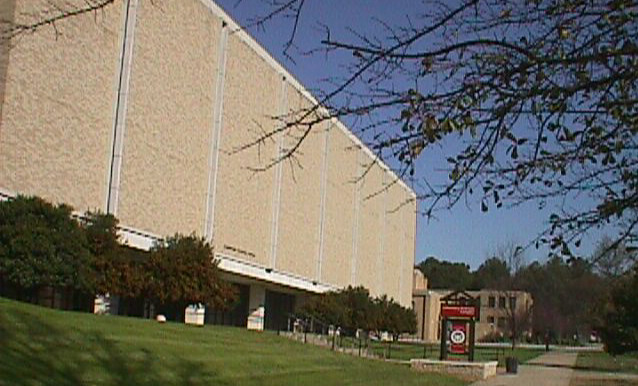
Department of Chemistry
and Physics
 |
Department of Chemistry and Physics |
| Worksheets |
General Chemistry Review
|

a) SeO3
b) CrF3•5H2O
c) HBr (aq)
d) Ac2(SO3)3
e) (NH4)2C2O4
2. Give the formula from the name for each:
a) ferric sulfate
b) diphosphorus pentasulfide
c) ruthenium(II) carbide
d) hypochlorous acid
e) manganic oxide
3. State the law of multiple proportions. State the law of definite proportions.
4. Given the following equation:
_____ Al2O3 + _____ Fe g _____ Fe3O4 + _____ Al
a) balance the equation
b) describe the type of reaction ________________________
c) determine the Fe:Al2O3 mole ratio ___________________
5. How would you prepare 75 mL of a 0.56 M solution of Ba(NO3)2 ?
6. How would you prepare 1.2 L of a 6 M H2SO4 solution if you start with a 18 M H2SO4 solution?
7. Write the electronic configuration for each of the following:
a) Ni
b) As
c) Li
d) Rn
e) Au
8. Give the number of valence electrons in each of the following:
| a) Cr | b) Al | c) Ti | d) B | e) Mn |
9. Draw an energy level diagram for Cr+2 and describe its magnetic properties.
10. List the types of quantum numbers, what each of them represent and the possible values for each. Be specific.
11. Which would have the larger ionization energy, Na or P? Why? Define ionization energy.
12. Which would be larger in size, C or C - 4? Why?
13. Of the five sets of quantum numbers listed below, 2 of
them are not valid. Circle the two incorrect sets of quantum numbers.
| (4, 2, 0, +1/2) | (4, 4, 0, -1/2) | (5, 2, -2, -1/2) | (8, 7, -6, +1/2) | (4, 1, +2, -1/2) |
14. Draw the Lewis Dot Structure for each of the following:
| a) AsF5 | b) SiCl4 | c) SO32- | d) AlH4- |
15. Describe the expected angles for PF3.
16. Describe the bonding in each of the following: (ionic,
polar covalent or covalent)
| a) CO2 | b) SiI4 | c) K2S | d) CoBr2 | e) SeO2 |
17. For each of the following, give the electron arrangement (E.A.) and the molecular geometry (M.G.).
E.A. M.G.
a) CO2
b) BrF3
c) AsI3
d) SO2
e) BrF4-
18. Describe the bonding in CO2. Include a diagram showing orbital overlap.
19. Given two molecules, Br2 and F2, which has the higher boiling point? Why?
20. Write the equilibrium expression for each of the following: Where possible, express both Kc and Kp. (Assume each of these are equilibria equations)
a) 2 NaN3 (s) g 2 Na (s) + 3 N2 (g)
b) 4 NH3 (g) + 5 O2 (g) g 4 NO (g) + 6 H2O (g)
21. According to Le Chatelier's Principle,
a) what effect would the addition of Cl- have on the equilibrium below?
CoCl2 + 2 Cl- g CoCl42-
b) what effect would the addition of Ag+ have on the equilibrium in problem 21a if the Ag+ precipitates as AgCl?
22. Calculate the pH of a 0.002 M NaOH solution.
23. For each pair of acids, circle the strongest one.
| a. | HCl | HBr |
| b. | HCl | H2S |
| c. | H2SO3 | H2SO4 |
| d. | CH4 | H2O |
| e. | H3PO4 | H3AsO4 |
24. For the following salts, define the resulting solutions as either acidic, basic or neutral.
a) NH4Br
b) Na2SO4
c) KF
d) sodium acetate
e) CaCl2
25. Calculate the equilibrium concentrations of a 0.2 M HF solution. Ka = 7.1 x 10-4
26. Define a basic oxide, acidic oxide and an amphoteric oxide.
27. Write the Ksp expression for each of the following:
a) AgCl (s) g Ag+(aq) + Cl- (aq)
b) Ag2CO3 (s) g 2 Ag + (aq) + CO32- (aq)
28. Given the Ksp = 2.4 x 10-4 for PbCl2, determine if a precipitate will occur from mixing 0.5 L of 0.02 M NaCl solution with 0.5 L 0.02 M Pb(NO3)2 solution.
29. Determine the Ksp for Ag2SO4 if the molar solubility is 1.5 x 10-2 M.
30. Fill in the blanks.
List the Group V cations________________________________
Reagent used to precipitate Group III cations __________
Reagent used to precipitate Group I cations ____________
31. Write the equation that relates DGo with the equilibrium constant K. Which way does the equilibrium lie if K < 1?
32. Determine the E for the Co+2/Co and Pb+2/Pb half-cells if the [Co+2] = 0.50 M and the [Pb+2] = 0.25 M.
33. Will I2 react with Pb? Explain. If it does react, what is (are) the product(s)? Give the balanced equation.
34. Write the solubility rules.
35. What are VSEPR rules and why are they important?
36. Define an Arrhenius acid/ base, Bronsted-Lowry Acid/ base and a Lewis acid/ base.
37. What is Ksp and what information does it give?
38. What is Ka and pKa? What does
the magnitude of the numbers tell us?